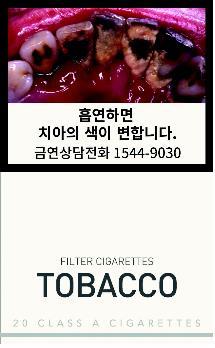S. Korea to change graphic warnings on cigarette packs in December
By YonhapPublished : May 14, 2018 - 13:28
South Korea will change the graphic warnings on cigarette packs in December, the health ministry said Monday, in the latest move to curb smoking.
In 2016, South Korea required tobacco companies to put the pictorial warnings on the upper part of both sides of cigarette packs to help reduce smoking. The photos are required to cover more than 30 percent of both sides of a packet.

The government changes the graphic warnings every 24 months as part of its efforts to maintain awareness of the side effects of smoking, according to the Ministry of Health and Welfare.
On Monday, the ministry announced 12 new pictorial warnings that will be placed on cigarette packs, including the electronic tobacco heating device called iQOS, starting on Dec. 23.
The graphic images show smokers suffering from fatal ailments, such as lung cancer, oral cancer, laryngeal cancer, heart attack and stroke, while also carrying warnings about serious side effects, such as the dangers of secondhand smoke, sexual dysfunction and premature death, according to the ministry.
The new graphic images include tooth discoloration, the ministry said.
The smoking rate for South Korean men aged 19 and older was 39.1 percent in 2016, down from 43.3 percent in 2014, according to government data. There was no government data on the smoking rate in 2015.
Separate data from the Organization for Economic Cooperation and Development put the smoking rate of South Korean men aged 15 and older at 31 percent in 2015, the highest among 15 OECD countries surveyed. Japan came in second with 30 percent, followed by Italy with 25 percent. (Yonhap)








![[Graphic News] More Koreans say they plan long-distance trips this year](http://res.heraldm.com/phpwas/restmb_idxmake.php?idx=644&simg=/content/image/2024/04/17/20240417050828_0.gif&u=)
![[KH Explains] Hyundai's full hybrid edge to pay off amid slow transition to pure EVs](http://res.heraldm.com/phpwas/restmb_idxmake.php?idx=644&simg=/content/image/2024/04/18/20240418050645_0.jpg&u=20240419100350)






![[From the Scene] Monks, Buddhists hail return of remains of Buddhas](http://res.heraldm.com/phpwas/restmb_idxmake.php?idx=652&simg=/content/image/2024/04/19/20240419050617_0.jpg&u=20240419175937)

![[KH Explains] Hyundai's full hybrid edge to pay off amid slow transition to pure EVs](http://res.heraldm.com/phpwas/restmb_idxmake.php?idx=652&simg=/content/image/2024/04/18/20240418050645_0.jpg&u=20240419100350)

![[Today’s K-pop] Illit drops debut single remix](http://res.heraldm.com/phpwas/restmb_idxmake.php?idx=642&simg=/content/image/2024/04/19/20240419050612_0.jpg&u=)